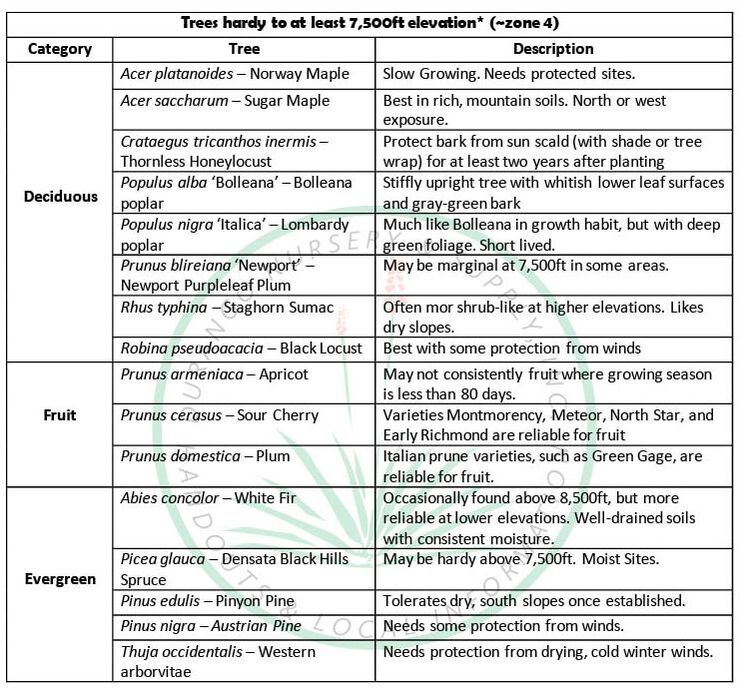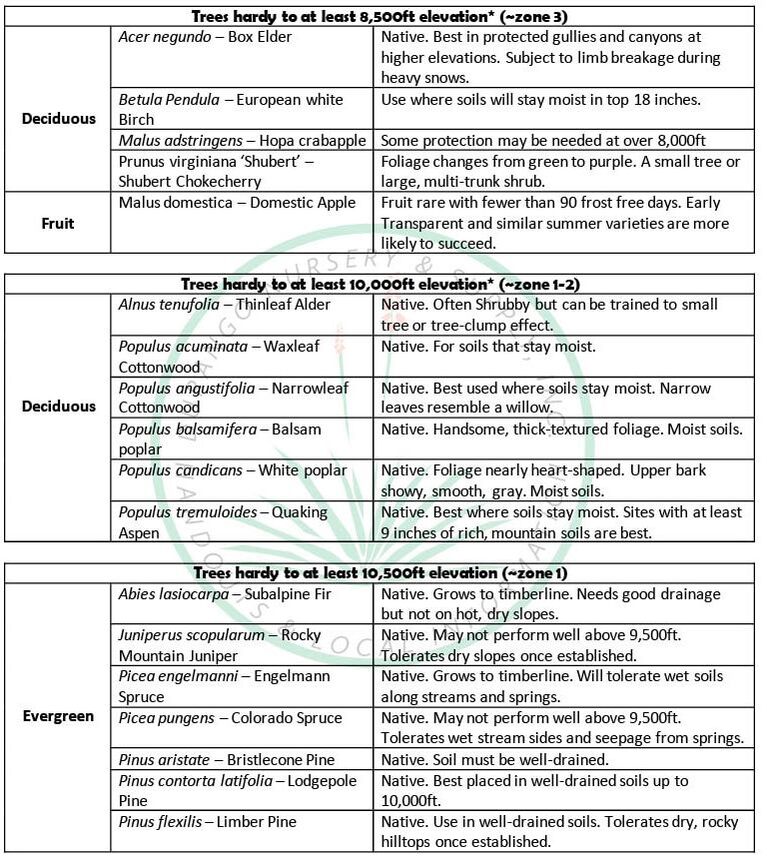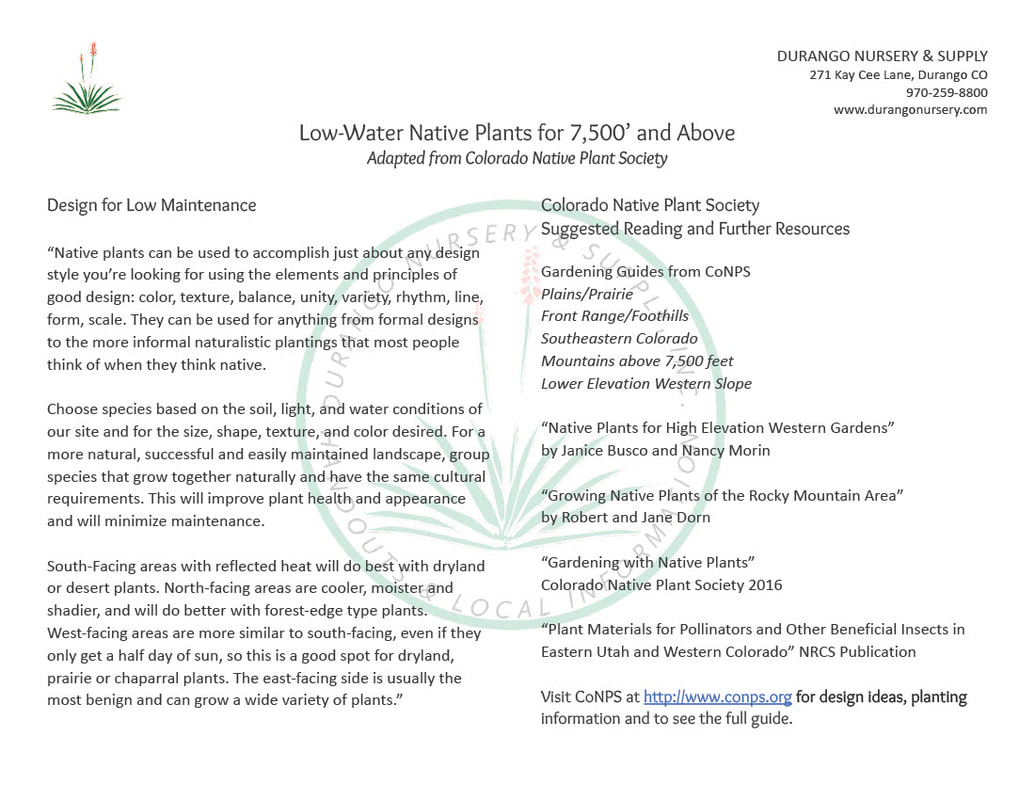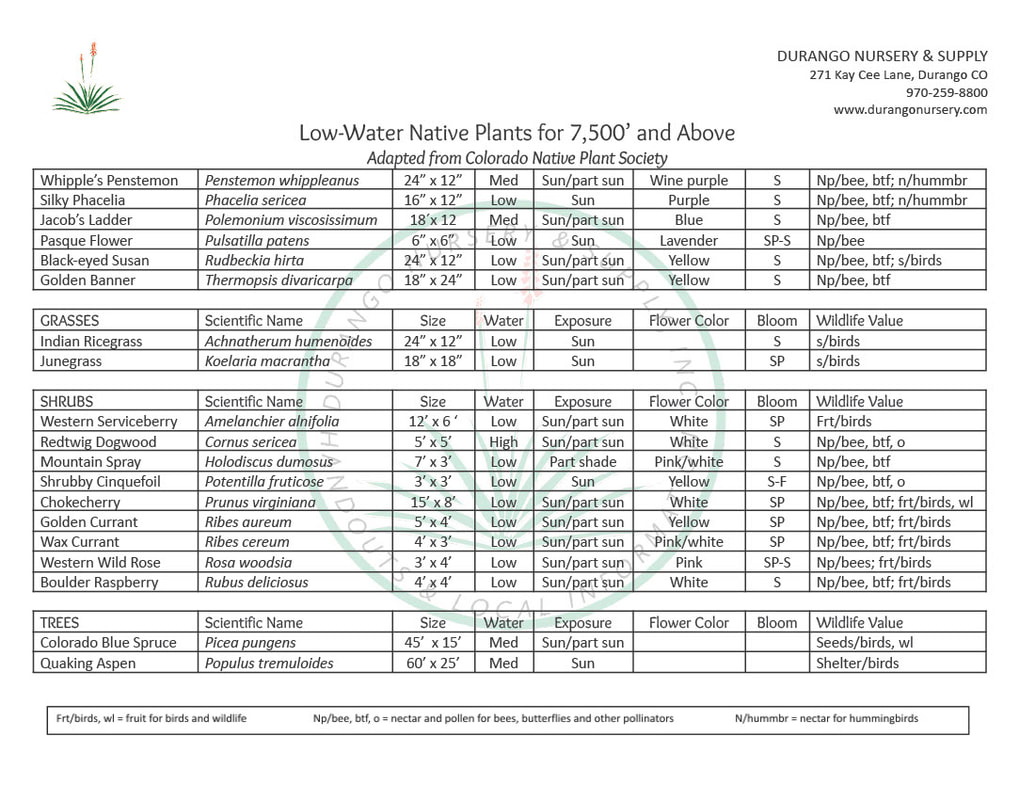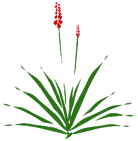What is a Zone?
|
The zone of a location is determined by the
average annual extreme minimum temperatures. Essentially, how cold an area typically is. |
The zone of a plant is determined by the
minimum temperature threshold of that species. Basically, the coldest temperature it can survive.
|
Other factors, such as elevation, exposure, and urbanization can impact your yards average temperatures.
Each yard is a micro-climate and could have average winter temperatures that differ to the surrounding area.
A courtyard or Southern Facing wall could be a different zone than a Northern facing wall on the same property.
If you live in Durango use Chapman Hill as a reference. Due to its proximity to the river and its minimal exposure to sunlight in winter, it is capable of staying colder and reaching colder temperatures hence it is a great place for snowy fun! If you plant a Zone 6 plant on that hill, it may not emerge from dormancy in spring. However, a zone 6 plant could live happily on the southern side of the hill or up at the college.
Record and use the Temperatures of your landscape to ensure correct Zone selection.
Changes to Gardening Zones
Get in the Gardening Zone
Last fall the USDA Plant Hardiness Zone Map was updated to represent recent temperature changes and trends. While we acknowledge the universal impact of global temperature increases, Durango Nursery is also filled with experienced gardeners familiar with the area and how to help your landscape survive any future extreme temperatures.
What is our USDA Zone and Why is it important?
The USDA zone of a location is determined by the average annual extreme minimum temperatures recorded in the area. The USDA takes the temperature averages of a region, city, or zip code to create a generalization based on recent temperature patterns. This correlates to the zone of a plant which is determined by the minimum temperature threshold of that species. In the past Durango has been classified broadly as a zone 5 indicating that the average extreme temperatures stay above -20 degrees Fahrenheit and therefore plants that are classified as zones 5 and below can survive outside over the winter consistently or be considered a perennial plant. Plants classified with a zone 6 or higher have difficulty surviving winters that reach below - 10 degrees Fahrenheit and would be considered an annual plant requiring replacement after exposure to said temperatures.
Above is a small copy of the recent USDA Plant Hardiness Zone Map and below is an enlarged image of those numbers explained. Warmer climates are depicted by warmer colors or higher numbers and colder climate are depicted by cooler colors and lower numbers. Plants can often live in regions represented with a similar color or number but may struggle on the opposite side of the scale, as a plant from Hawaii (mostly orange) could not survive a winter in Alaska (mostly purple).
Below is a snippet of our region and its recently updated Zone map. While most states may have a northern progression of 2 - 3 zones, Colorado has about 5 different zones centered around the mountains. This shows why the regional assumptions that this map portrays may NOT apply to your landscape! Durango has been reclassified to zone 6 but many additional factors including exposure, elevation, or proximity to rivers or lakes may exclude your landscape from these general parameters. This can cause some confusion while selecting plants that will thrive for years in your landscape for years to come.
Protecting your Landscape Investment
We too have to be extremely considerate of each plant and species threshold because each plant purchased is an investment. We do not have a lot of Greenhouse space for Tender Vegetables, Annual flowers, and Tropical house plants which is why we have to wait until the days surrounding our Average Final Frost Date of May 26th to bring in the full selection. However, everything that we keep outside during the tumultuous temperatures of spring are considered hardy and are already blooming!
The best way to deduce the zone of your landscape is through your experience, more so than the map. Think back to the coldest morning temperature that you can recall from recent winters and round down to find what zone your property is. Keep in mind that the southern side of a property could be a few degrees warmer while the northern or shaded portions will be a few degrees colder. Any plant in a zone higher than that of your landscapes will require additional care or to come inside during cold seasons. If you do not want to replace a plant, we recommend overwintering it indoors or in a greenhouse.
We are going to advocate to residents to stick to zone 5 for a few more years until we start to experience temperatures representative of a zone 6 on our property. However, our property is close to the river and is consistently a touch colder than town. Your landscape could be a zone 6 based on your deductions and our plant selection will include zone 6, tender perennial, and annual options. Yet we will continue to focus on hardy plants suitable for all surrounding counties as Zone 5 plants can still survive in a zone 6 environment, but a zone 6 plant will not survive a zone 4 environment winter.
What other factors should I consider when purchasing Plants?
The zone of your yard is an important factor in plant selection but your goals, sun exposure, and water access can help us point you in the right direction on site. At Durango Nursery you will find most of our annual flowers and vegetables located in front of our two greenhouses. Our Perennials, Shrubs, and Trees are organized outside this area based on size, sun exposure preference, and special abilities (fruiting, flowering, xeric, etc). Plants will each have an ID sign, tag, or information that will highlight the zone of the plant as well as information about care requirements. Using these details and your deductions about the landscape you can design your perfect paradise like a pro!
Last fall the USDA Plant Hardiness Zone Map was updated to represent recent temperature changes and trends. While we acknowledge the universal impact of global temperature increases, Durango Nursery is also filled with experienced gardeners familiar with the area and how to help your landscape survive any future extreme temperatures.
What is our USDA Zone and Why is it important?
The USDA zone of a location is determined by the average annual extreme minimum temperatures recorded in the area. The USDA takes the temperature averages of a region, city, or zip code to create a generalization based on recent temperature patterns. This correlates to the zone of a plant which is determined by the minimum temperature threshold of that species. In the past Durango has been classified broadly as a zone 5 indicating that the average extreme temperatures stay above -20 degrees Fahrenheit and therefore plants that are classified as zones 5 and below can survive outside over the winter consistently or be considered a perennial plant. Plants classified with a zone 6 or higher have difficulty surviving winters that reach below - 10 degrees Fahrenheit and would be considered an annual plant requiring replacement after exposure to said temperatures.
Above is a small copy of the recent USDA Plant Hardiness Zone Map and below is an enlarged image of those numbers explained. Warmer climates are depicted by warmer colors or higher numbers and colder climate are depicted by cooler colors and lower numbers. Plants can often live in regions represented with a similar color or number but may struggle on the opposite side of the scale, as a plant from Hawaii (mostly orange) could not survive a winter in Alaska (mostly purple).
Below is a snippet of our region and its recently updated Zone map. While most states may have a northern progression of 2 - 3 zones, Colorado has about 5 different zones centered around the mountains. This shows why the regional assumptions that this map portrays may NOT apply to your landscape! Durango has been reclassified to zone 6 but many additional factors including exposure, elevation, or proximity to rivers or lakes may exclude your landscape from these general parameters. This can cause some confusion while selecting plants that will thrive for years in your landscape for years to come.
Protecting your Landscape Investment
We too have to be extremely considerate of each plant and species threshold because each plant purchased is an investment. We do not have a lot of Greenhouse space for Tender Vegetables, Annual flowers, and Tropical house plants which is why we have to wait until the days surrounding our Average Final Frost Date of May 26th to bring in the full selection. However, everything that we keep outside during the tumultuous temperatures of spring are considered hardy and are already blooming!
The best way to deduce the zone of your landscape is through your experience, more so than the map. Think back to the coldest morning temperature that you can recall from recent winters and round down to find what zone your property is. Keep in mind that the southern side of a property could be a few degrees warmer while the northern or shaded portions will be a few degrees colder. Any plant in a zone higher than that of your landscapes will require additional care or to come inside during cold seasons. If you do not want to replace a plant, we recommend overwintering it indoors or in a greenhouse.
We are going to advocate to residents to stick to zone 5 for a few more years until we start to experience temperatures representative of a zone 6 on our property. However, our property is close to the river and is consistently a touch colder than town. Your landscape could be a zone 6 based on your deductions and our plant selection will include zone 6, tender perennial, and annual options. Yet we will continue to focus on hardy plants suitable for all surrounding counties as Zone 5 plants can still survive in a zone 6 environment, but a zone 6 plant will not survive a zone 4 environment winter.
What other factors should I consider when purchasing Plants?
The zone of your yard is an important factor in plant selection but your goals, sun exposure, and water access can help us point you in the right direction on site. At Durango Nursery you will find most of our annual flowers and vegetables located in front of our two greenhouses. Our Perennials, Shrubs, and Trees are organized outside this area based on size, sun exposure preference, and special abilities (fruiting, flowering, xeric, etc). Plants will each have an ID sign, tag, or information that will highlight the zone of the plant as well as information about care requirements. Using these details and your deductions about the landscape you can design your perfect paradise like a pro!
As the Leaf Turns
5.20.2024
Trees for High Elevations
|
*Includes Trees listed for Higher Elevations
| |||||||
©Durango Nursery and Supply 2024. All Rights Reserved

